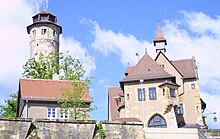Gustav Haeberle
Gustav Haeberle (born April 14, 1853 in Memmingen ; † January 1930 in Bamberg ) was a German architect and representative of historicism .
Live and act
Gustav Haeberle studied architecture in Stuttgart and engineering in Munich . He then worked as a construction assistant in his hometown before moving to Bamberg in this role in 1877. He was supposed to work here until the end of his life and with over 100 buildings to influence the cityscape to this day. One of his early works was drawing up the plans for today's Clavius Gymnasium . His marriage to Kunigunde Weyermann in 1880 also gave him professional advantages, as he got into the circle of dignitaries in the Altenburg Association, which helped him to receive two of his most formative commissions: the complex of the malt factory of his brother-in-law Johann Baptist Weyermann(whose structural development he accompanied over decades) and the renovation of the Altenburg .
In his capacity as district building technician and district building consultant, he was responsible for several school buildings and churches in the Bamberg district, the renovation of the Marienkapelle and the old town hall in Scheßlitz . With his style, which took up the Munich historicism of a Gabriel von Seidl in a considerate, playful imagination , he met the taste of the early days. His works as a careful and hardworking businessman were commissioned mainly by up-and-coming entrepreneurs of these days: often residential buildings, but also functional buildings such as factories and warehouses. In addition to the already mentioned main works Weyermann and Altenburg, he was also responsible for the design of Brennerstrasse, Kunigundendamm and Michelsberg for several years. The urban integration of his buildings was important to him. As one of the first architects, he used the photomontage technique to make the visual relationships and effects of his projects clear. Whenever the opportunity arose, Haeberle tried to make his buildings appear as a whole by designing details such as railings, tiles and window handles. In contrast to his buildings, the often elaborate interior fittings have mostly not been preserved. Exceptions can be found on Altenburg, for example, but also in the Grüner Markt 16 office building in the “Haeberle room” in the Hübscher bookstore.
plant
Buildings and designs (selection)
- 1877: "Realschule" (today's Clavius-Gymnasium) in Bamberg, Kapuzinerstraße 29
- 1878: Klarissenkaserne in Bamberg, Schillerplatz 13 and 15 (not preserved)
- 1879: Main bridges in Breitengüßbach and Hallstadt
- 1883: “Villa Trautheim” owned by the pharmacist Sippel, Laurenzistraße 28, rebuilt in 1892 after a fire
- 1884: Marienkapelle in Scheßlitz
- 1885: Chapel and school house in Oberoberndorf
- 1887: Marienbrunnen on Scheßlitz market square
- 1888–1929: Malthouse and Villa Weyermann in Bamberg, Brennerstraße 15/19
- 1889: Mariahilfanstalt in Bamberg, Stephansplatz 2
- 1889: Buchner CC and Sons' house (today's Medienhaus Hübscher) in Bamberg, Grüner Markt 16
- 1890: Knabenhort in Bamberg, Amalienstraße 10
- 1891: Pub in the "Hotel Krone" in Bamberg, Lange Straße 12/14
- 1891–1902: Reconstruction of the Altenburg in Bamberg
- 1892: Semi-detached house with "Hotel Kaiserhof" in Bamberg, Luitpoldstrasse 45/47
- 1892: Privileged shooting society in Bamberg, Schönleinsplatz 1 (replaced in the 1950s by the new building of the Sparkasse)
- 1894: School in Demmelsdorf
- 1894: Steinknock pilgrimage chapel in Mistendorf
- 1894–1896: Evangelical parish church St. Johannis in Forchheim
- 1897–1911: Gross & Bohrer in Bamberg, Zollnerstrasse 76
- 1898: Kipfmüller department store in Bamberg, Hauptwachstrasse 15/17
- 1898: Reconstruction of the old town hall in Scheßlitz
- 1899: Church of the Sacred Heart of Jesus in Schwürbitz
- 1899–1912: Houses in Bamberg, Kunigundendamm
- 1899: Witt department store in Bamberg, Obere Königstrasse 20
- 1900: Holy Family Church in Windischletten
- 1901: Villa Horn (later Karl May Museum) in Bamberg, Hainstrasse 11
- 1902: House of the coachman Georg Alt in Bamberg, Josefstrasse 7
- 1902–1912: Several villas on Michelsberg in Bamberg (including Villa Schröppel)
- 1903: Martin Luther Church in Lichtenfels
- 1903: Moritz Horn shaft factory in Bamberg, Amalienstraße 11a
- 1903: Formerly a Catholic branch church Septem Dolores in Gundelsheim , today a Protestant St. Mark's Church
- 1904: Villa Urban in Bamberg, Wildensorger Straße 8
- 1906–1914: Residential houses in the vicinity of the Weyermann malt house in Bamberg, Brennerstrasse
- 1907: Expansion of the Mahr brewery , Wunderburg 12
- 1907–1927: Sanatorium in Bischofsgrün
- 1909: The Maisel Brewery in Bamberg, Obere Königstrasse 38
- 1911: Children's institution in Bamberg, Kleberstrasse 30
- 1911: Villa Türk & Kneitz in Kulmbach , Luitpoldstrasse 9
- 1914: Regatta house in Bamberg, Hain city park
- 1920: Extension of the residential building on the Maisel-Bräu, Moosstrasse 46
Web links
Individual evidence
- ^ Karin Dengler-Schreiber: Gustav Haeberle, architect (1853-1930). In: Report of the Historical Association Bamberg. Vol. 136, 2000, pp. 195–243, PDF ( Memento from February 6, 2015 in the Internet Archive )
| personal data | |
|---|---|
| SURNAME | Haeberle, Gustav |
| BRIEF DESCRIPTION | German architect |
| DATE OF BIRTH | April 14, 1853 |
| PLACE OF BIRTH | Memmingen |
| DATE OF DEATH | January 1930 |
| Place of death | Bamberg |
















